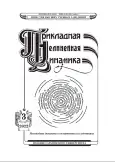Transition from ergodic to many-body localization regimes in open quantum systems in terms of the neural-network ansatz
- Authors: Yusipov I.I.1, Kozinov E.A.1, Laptyeva T.V.1
-
Affiliations:
- Lobachevsky State University of Nizhny Novgorod
- Issue: Vol 30, No 3 (2022)
- Pages: 268-275
- Section: Articles
- URL: https://journals.rcsi.science/0869-6632/article/view/252080
- DOI: https://doi.org/10.18500/0869-6632-2022-30-3-268-275
- ID: 252080
Cite item
Full Text
Abstract
About the authors
Igor I. Yusipov
Lobachevsky State University of Nizhny Novgorod
ORCID iD: 0000-0002-0540-9281
603950 Nizhny Novgorod, Gagarin Avenue, 23
Evgeniy Aleksandrovich Kozinov
Lobachevsky State University of Nizhny Novgorod
ORCID iD: 0000-0001-6776-0096
603950 Nizhny Novgorod, Gagarin Avenue, 23
Tatjana Vladimirovna Laptyeva
Lobachevsky State University of Nizhny Novgorod
ORCID iD: 0000-0002-9172-9424
603950 Nizhny Novgorod, Gagarin Avenue, 23
References
- Bellman RE. Dynamic Programming. Princeton: Princeton University Press; 1957. 365 p.
- Meyerov I, Liniov A, Ivanchenko M, Denisov S. Simulating quantum dynamics: Evolution of algorithms in the HPC context. Lobachevskii Journal of Mathematics. 2020;41(8):1509-1520. doi: 10.1134/S1995080220080120.
- Eisert J, Cramer M, Plenio MB. Colloquium: Area laws for the entanglement entropy. Rev. Mod. Phys. 2010;82(1):277-306. doi: 10.1103/RevModPhys.82.277.
- Vidal G. Efficient classical simulation of slightly entangled quantum computations. Phys. Rev. Lett. 2003;91(14):147902. doi: 10.1103/PhysRevLett.91.147902.
- Carleo G, Troyer M. Solving the quantum many-body problem with artificial neural networks. Science. 2017;355(6325):602-606. doi: 10.1126/science.aag2302.
- Levine Y, Sharir O, Cohen N, Shashua A. Quantum entanglement in deep learning architectures. Phys. Rev. Lett. 2019;122(6):065301. doi: 10.1103/PhysRevLett.122.065301.
- Goodfellow I, Bengio Y, Courville A. Deep Learning. Cambridge, Massachusetts: The MIT Press; 2016. 800 p.
- Melko RG, Carleo G, Carrasquilla J, Cirac JI. Restricted Boltzmann machines in quantum physics. Nature Physics. 2019;15(9):887-892. doi: 10.1038/s41567-019-0545-1.
- Deng DL, Li X, Das Sarma S. Quantum entanglement in neural network states. Phys. Rev. X. 2017;7(2):021021. doi: 10.1103/PhysRevX.7.021021.
- Lindblad G. On the generators of quantum dynamical semigroups. Commun. Math. Phys. 1976;48(2):119-130. doi: 10.1007/BF01608499.
- Vicentini F, Biella A, Regnault N, Ciuti C. Variational neural-network ansatz for steady states in open quantum systems. Phys. Rev. Lett. 2019;122(25):250503. doi: 10.1103/PhysRevLett.122.250503.
- Hartmann MJ, Carleo G. Neural-network approach to dissipative quantum many-body dynamics. Phys. Rev. Lett. 2019;122(25):250502. doi: 10.1103/PhysRevLett.122.250502.
- Torlai G, Melko RG. Latent space purification via neural density operators. Phys. Rev. Lett. 2018;120(24):240503. doi: 10.1103/PhysRevLett.120.240503.
- Yoshioka N, Hamazaki R. Constructing neural stationary states for open quantum many-body systems. Phys. Rev. B. 2019;99(21):214306. doi: 10.1103/PhysRevB.99.214306.
- Vakulchyk I, Yusipov I, Ivanchenko M, Flach S, Denisov S. Signatures of many-body localization in steady states of open quantum systems. Phys. Rev. B. 2018;98(2):020202. doi: 10.1103/PhysRevB.98.020202.
- Pal A, Huse DA. Many-body localization phase transition. Phys. Rev. B. 2010;82(17):174411. doi: 10.1103/PhysRevB.82.174411.
- Becca F, Sorella S. Quantum Monte Carlo Approaches for Correlated Systems. Cambridge: Cambridge University Press; 2017. 274 p. doi: 10.1017/9781316417041.
- NetKet [Electronic resource]. Available from: https://www.netket.org.
Supplementary files










